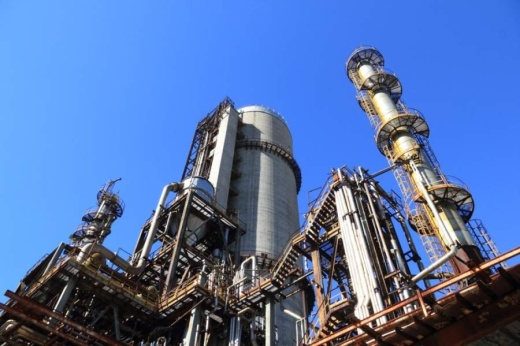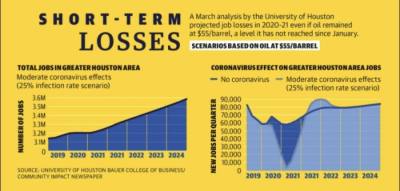As the economy reopens, jobs will continue to be lost in and adjacent to the energy sector in the Katy area, said Jesse Thompson, senior business economist with the Federal Reserve Bank of Dallas, Houston Branch.
“There are a lot of businesses for example in the Katy area that you might think are indirectly in the oil and gas business because all of their customers are in the oil and gas business,” Thompson said. “That may be an interior decorator and, to some extent, a dealership selling trucks. Peoples budgets are going to be tightening up within and around the oil and gas industry.”
Why oil prices plunged
Last month, oil prices crashed into negative digits, ending at -$37.63 per barrel April 20, according to Nasdaq Inc.
Bill Gilmer, director of the University of Houston Bauer Institute for Regional Forecasting, said the historically low oil prices stemmed from the expiration of oil futures contracts as of April 21.
Analysts expected prices for oil per barrel as low as single digits as the scenario unfolded, and while the figure being a negative number was likely a one-time event, oil prices may not see major gains for several months, Gilmer said. June contracts were at about $15 per barrel as of the morning of April 21, with July at $23 and fall contracts possibly back into the $35-$40 range again, Gilmer said.
Although the oil and gas industry was already seeing layoffs in 2019, the stay-at-home orders induced by the COVID-19 pandemic further exacerbated the struggle for the oil and gas industry, Thompson said.
“The pandemic hit, the stay-at-home-orders rolled out across the world, and people stopped moving,” Thompson said. “Most of the liquid fuel we consume, almost all of it, goes into moving people, so if people stop moving, we stop burning fuel.”
Thompson added the virus curtailed consumption and while production coming out of the ground was increasing, production going into refineries was decreasing.
“The oil was getting dumped into storage very quickly, and we started running out of space, and now, the oil fields are shutting in,” he said.
Oil prices were already dwindling in January because 2019 was not a great year for the oil and gas industry, in part due to the Russian-Saudi price war, Hirs said.
“Layoffs and write-offs losses were recognized even before Dec. 31,” Hirs said. “Layoffs were being made after Christmas and at the end of January; then, it began to accelerate in February.”
The economy
There are a few oil and gas companies in Katy, but the area will not suffer as much as Midland and Odessa, said Ed Hirs, energy economist at the University of Houston.
“The Katy area has the folks who work for the headquarters in oil and gas research and development, which tends to weather downturns better than most places in the oil patch,” Hirs said. “This is primarily because the oil field workers are not here, but the capital and intellectual capital are here.”
Hirs added the drilling in Midland and Odessa started slowing in January and February of this year, and companies will not drill new wells for the remainder of 2020.
“I don't know how many people live out in Katy and commute to the Energy Corridor for work,” Hirs said. “Clearly, there are layoffs in the Katy area for Schlumberger, Halliburton and other oil companies, but it's not everybody getting laid off like it is in Midland and Odessa.”
International Energy Agency projects about a 25% cut in global demand for the second quarter of 2020, and the Greater Houston economy is projected to see more job losses in the oil and gas industry in the second half of 2020, according to local economists.
“Diesel is the fuel of essential industries, so it didn’t get curtailed as [sharply], but it fell by about one third,” Thompson said. “... A little over a quarter of total petroleum products demand went away in the course of one month.”
Weekly jet fuel demand in the U.S. fell by about 75% from early March to early April, and motor fuel fell by a little over 50% in that time, Thompson said.
WTI, or crude oil prices, should rise to about $50 per barrel before the industry to make profit and begin stabilizing, Thompson said.
“The differentiator between the Greater Houston area and the rest of the country is usually energy,” Thompson said. “In this crisis, it will perform relatively poorly compared to ... the United States because of what is going on in energy right now.”
Although it is impossible to predict how long it will take for oil and gas and the overall economy to stabilize, Thomson said once the energy market stabilizes, the area will resume its historical pattern of outperforming the rest of the country.
“This is not the end of oil and gas,” he added. "But for the foreseeable future, the virus is in the driver's seat. Until the virus, infections and death are contained and we've gone back to some semblance of normal, it is unlikely that we will see stable oil prices at a healthy level."






